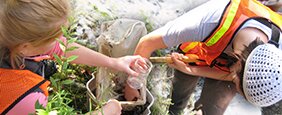Unit Overview
Once the researchers have developed their hypotheses and have an understanding of what data they will need to collect to support their hypotheses they will need to explicitly design their experiment, pull together the materials and methods, or protocols, that they need, collect their samples, keep records of their samples and their sampling events, and submit their samples for analysis. This data collection, this accumulation of the numbers and observations, is essential to support or refute the hypothesis.
Here are general rules of the road:
- Make defensible research plans
- Be systematic and collect the same type of data in the same way
- Take very careful field and lab notes, fill out the field datasheets
- Record observations
- Observations can be either quantitative (numeric) or qualitative (words, relative amounts) and observations can be made of anything you can see. You can count trees, list species, weigh leaves, say whether a certain animal or plant is present or absent.
- Enter the data into a spreadsheet in order to analyze and graph it
- Check it twice to minimize errors whenever you can
- Remember! Proper prior preparation prevents poor performance
Students can collect data for many field parameters, other than the samples they may end up submitting for analysis, to help refine their system thinking and support their hypotheses.
Rationale
Field sampling is exciting and can give your researchers ownership over the project that they would not have otherwise. If you have not been able to take your students out to their field site yet then field sampling is the way to give the students’ system model concreteness and context that it will not have otherwise.
Objectives
- Develop a sampling strategy
- Prepare for collection of samples and data
- Collect samples and data necessary to support the evaluation of hypotheses
Instructional Strategies
There are many different ways to go field sampling.
We recommend:
- Practice everything that you can beforehand, in the classroom (of, if appropriate, on a playing field).
- Put students in charge of assembling and checking their own field gear.
- Give everyone a field job; have them practice their field job (including keeping track of the material that they are responsible for).
- Make sure field data sheets are filled out and returned to the classroom.
Concepts and Relationships to think about:
- There is a relationship between the samples collected and the collection sites?
- There is a reason for keeping tools, materials, and hands clean when gathering samples?
- Why keeping accurate field data is important
- Why proper labeling is important
- It is important to take ONLY the organisms or substances needed for a meaningful sample
Vocabulary:
- Hypothesis—a well-reasoned answer to a research question
- Research project design—the outline of how an experiment will be conducted
- Sampling—the collection of a few specimens of one specific type of organism
Student Prerequisites:
What students need to know to complete this unit:
- What their hypothesis is
- Where they might expect to find the samples they need to support their hypothesis
Misconceptions:
- It doesn’t matter how the samples are collected
- It doesn’t matter how many organisms we kill

 Acadia Learning brings scientists, teachers, and students together in partnerships that result in useful research and effective science education.
Acadia Learning brings scientists, teachers, and students together in partnerships that result in useful research and effective science education.